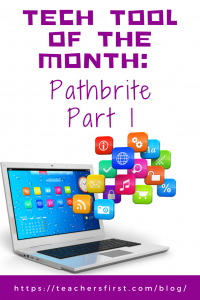Pathbrite is a tool you can use to create digital portfolios by adding text, videos, photos, links, documents, and much more. Once you have added your content, you can click and drag the pieces where you want them to appear on your portfolio. Students can also “like” and add comments to other students’ portfolios. Pathbrite portfolios are free for individual users and offer an excellent way to demonstrate understanding, create a “show what you know project,” or reflect after a lesson or unit. Pathbrite does require an email to sign up, so we have recommended this tool for secondary students, but if your elementary students have email accounts through your school, this would be very easy for them to use.
While the intent of this blog post is to share ways that older students could use this digital portfolio tool, it should be noted that teachers can also use Pathbrite to create a digital portfolio to share content with students of all ages as an engaging active-learning lesson.
Applying the Triple E Framework
The Triple E Framework, created by Dr. Liz Kolb, is built on the belief that “effective technology integration begins with good instructional strategies and not fancy tools” (tripleeframework.com). Dr. Kolb wrote a book on the topic, Learning First, Technology Second (ISTE, 2017), that lays out the three main uses for technology in education: to Engage, Enhance, or Extend learning goals. We can use this framework to decipher why we are using specific tools in the classroom. Here is a rubric based on the Triple E Framework you can use to evaluate whether Pathbrite (or any other technology) is a good fit with your learning goals and whether you should use Pathbrite in your lesson.
- Engage in learning goals: When using Pathbrite, students take on the role of active learner as they add content pieces into their digital portfolio. Students are more focused on the task because they are engaged in online activities as they work at their own pace. Pathbrite helps motivate students to begin the learning process, as the material is presented in an organized and non-distracting manner. Teachers (and students) can determine what visual format they would like, all of which are clean and non-distracting.
- Enhance learning goals: This tool enhances learning goals because it allows students to demonstrate a more sophisticated understanding of the content by creating digital portfolios that include videos, text, images, documents, and more. Students can use this technology to make connections that help them understand concepts and ideas presented in class. Students can also share and convey their understanding by creating their own Pathbrite digital portfolios, giving them a deeper understanding of the content that they are sharing.
- Extend learning goals: Dr. Kolb describes extended learning as an opportunity for students to learn, connect, and collaborate outside of the regular school day and as a bridge between the school day and real-life experiences. This tool would work well with flipped, blended, and remote learning lessons. We are preparing our students for a world that doesn’t exist yet, but most jobs do require independent motivation and knowledge of technology. Pathbrite allows students to practice skills they will use in the future, as many classes and careers will require students to use technology and to work through various steps of lessons or projects to completion. Students can also connect outside of the classroom, as they can share their portfolios with classmates and comment on other students’ portfolios.
SAMR Connection
The SAMR Model, by Dr. Ruben Puentedura, suggests that technology implementation has four levels. We can use this model as a guideline to analyze how we’re using technology tools in the classroom. Depending on how you are using Pathbrite, your lesson could be considered at the Substitution, Modification, or Redefinition level of SAMR.
- Substitution: At the level of substitution, the technology acts as a direct substitute with no functional change. When students use digital portfolios that were created by their teacher, Pathbrite is at the substitution level. An example of using this tool at the level of substitution is providing some simple text on a digital portfolio. Students simply click to read the text within the portfolio rather than having you say it out loud or write it on a chalkboard.
- Modification: The level of Modification allows us to make (or modify) the activity into something more integrated with technology, meaning there is significant task redesign. When students are creating their own digital portfolios, they enter the level of modification. While students could create a portfolio on paper, a digital portfolio allows students to quickly add videos, documents, links to resources, and much more. Students can curate several pieces of information in a neat package using the digital portfolio content options at Pathbrite.
- Redefinition: At the highest level of SAMR, the technology is allowing for the creation of new tasks that were not previously possible without technology. To reach this level of SAMR, students would not only create their digital portfolios, but they would also share their portfolios with classmates, comment on other portfolios, and possibly make changes to their portfolio based on the feedback.
Don’t miss Part 2 of the Tech Tool of the Month: Pathbrite, where we’ll discuss how to use the tool and introduce ways to use it in the classroom. In the meantime, let us know in the comment section below how you have used Pathbrite in your education setting.



2 thoughts on “Tech Tool of the Month: Pathbrite – Part 1”